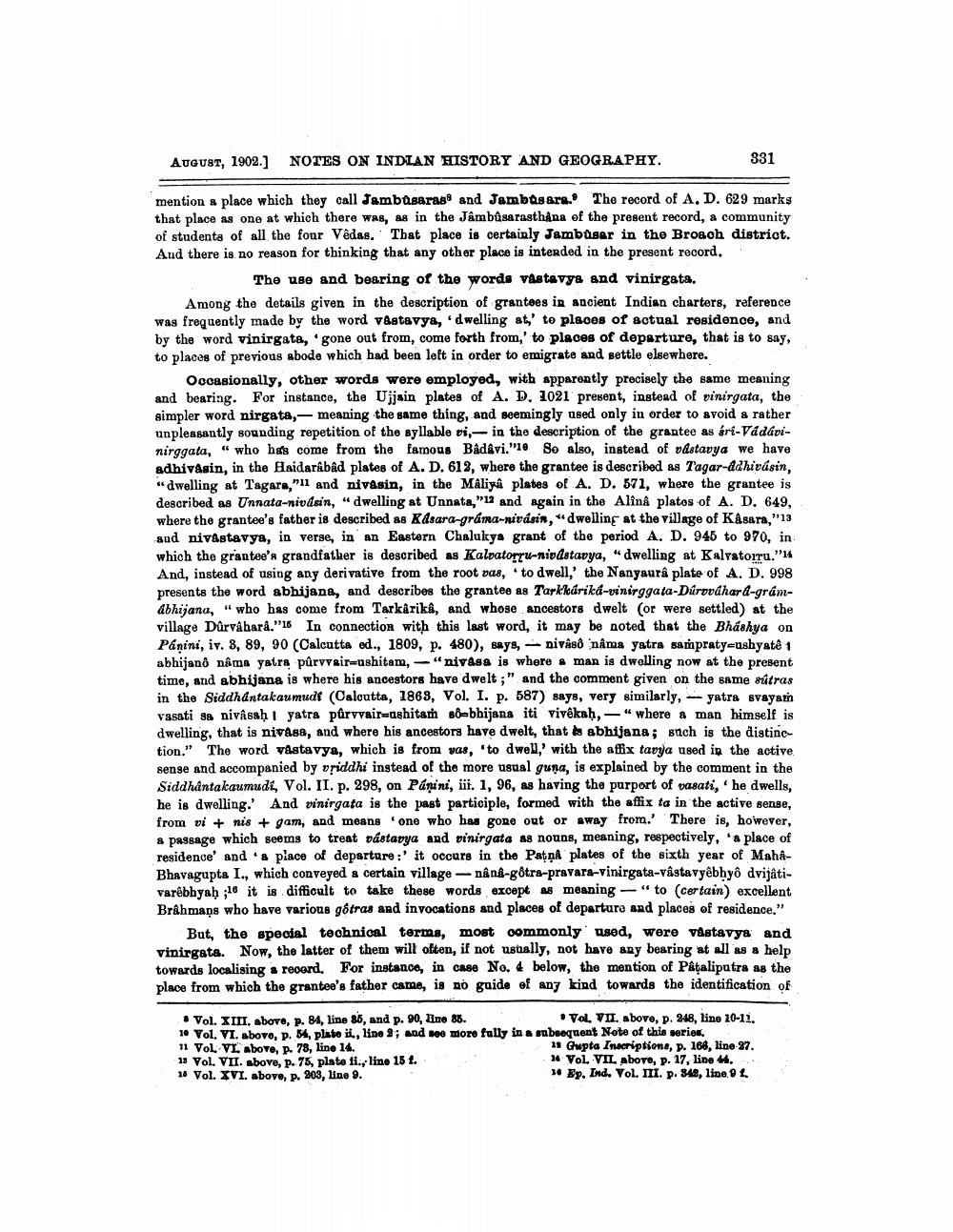________________
AUGUST, 1902.] NOTES ON INDIAN HISTORY AND GEOGRAPHY.
331
mention a place which they call Jambtsarase and Jambos are. The record of A. D. 629 marks that place as one at which there was, as in the Jâmbûsarasthåna of the present record, a community of students of all the four Vedas. That place is certainly Jambusar in the Broach district. Aud there is no reason for thinking that any other place is intended in the present record. .
The use and bearing of the words vastavye and vinirgata. Among the details given in the description of grantees in ancient Indian charters, reference was frequently made by the word vastavya, dwelling at,' to places of actual residence, and by the word vinirgata, 'gone out from, come forth from,' to places of departure, that is to say, to places of previous abode which had been left in order to emigrate and settle elsewhere.
Occasionally, other words were employed, with apparently precisely the same meaning and bearing. For instance, the Ujjain plates of A. D. 1021 present, instead of vinirgata, the simpler word nirgata,- meaning the same thing, and seemingly used only in order to avoid a rather unpleasantly sounding repetition of the syllable vi,- in the description of the grantee as Sri-Vadávinirggata, “who has come from the famous Bad&vi."le So also, instead of vastavya we have adhivåsin, in the Haidarabad plates of A. D. 612, where the grantee is described as Tagar-ddhivásin,
dwelling at Tagara,"l1 and nivåsin, in the Maliyê plates of A. D. 571, where the grantee is described as Unnata-nivdsin, " dwelling at Unnata,"12 and again in the Alina platos of A. D. 649, where the grantee's father is described as Kasara-gráma-nivásin, dwelling at the village of Kåsara,"13 and nivåstavya, in verse, in an Eastern Chalukya grant of the period A. D. 945 to 970, in which the grantee's grandfather is described as Kalvatorru-nivdstavya, " dwelling at Kalvatoiru."'14 And, instead of using any derivative from the root vas, to dwell,' the Nanyaurâ plate of A. D. 998 presents the word abhijana, and describes the grantee as Tarkkáriká-vinirggata-Dúrovdhard-grámabhijana, " who has come from Tarkarika, and whose ancestors dwelt (or were settled) at the village Dûrváhara.”16 In connection with this last word, it may be noted that the Bhashya on Panini, iv. 8, 89, 90 (Calcutta ed., 1809, p. 480), says, Divásố nấma yatra sampraty=ushyate 1 abhijanô nêma yatra pûrvvair=ushitam, -"nivasa is where a man is dwelling now at the present time, and abhijana is where his ancestors have dwelt;" and the comment given on the same rútras in the Siddhantakaumudi (Calcutta, 1868, Vol. I. p. 587) says, very similarly, - yatra svayam vasati sa nivåsah yatra pârvvair=ashitam 88-bhijana iti vivekah, - " where a man himself is dwelling, that is nivasa, and where his ancestors have dwelt, that is abhijana; such is the distinction." The word vastavya, which is from was, 'to dwell,' with the affix tavya used in the active sense and accompanied by vriddhi instead of the more usual guna, is explained by the comment in the Siddhantakaumudi, Vol. II. p. 298, on Pánini, iii. 1, 96, as having the purport of vasati,' he dwells, he is dwelling.' And vinirgata is the past participle, formed with the affix ta in the active sense, from vi + nis + gam, and means one who has gone out or away from. There is, however, & passage which seems to treat vástavya and vinirgata as nouns, meaning, respectively, a place of residence and a place of departure :' it occurs in the Patņå plates of the sixth year of MaháBhavagupta I., which conveyed a certain village - nâng-gôtra-pravara-vinirgata-vastavyébhyô dvijâtivarebbyah ;16 it is difficult to take these words except as meaning -" to certain excellent Brahmaps who have various gatras and invocations and places of departure and places of residence."
But, the specdal tochnical terms, most commonly used, wore vastavys and vinirgata. Now, the latter of them will often, if not usually, not have any bearing at all as a help towards localising a record. For instance, in case No. 4 below, the mention of Pataliputra as the place from which the grantee's father came, is no guide of any kind towards the identification of
• Vol. XIII, above, p. 84, line 85, and p. 90, ne 85.
• Vol. VIL. above, p. 248, line 20-12. 16 Vol. VI. abovo, p. , plato ii., line 9; and nee more fully in a subsequent Note of this series. 11 VOL VL above, p. 78, line 14.
11 Gupta Inscriptions, p. 168, line 87 13 Vol. VII. above, p. 75, plate fi., line 15 t.
# VOL VIL. above, p. 17, line , 16 Vol. XVI. above, p. 203, line 9.
Ep. Ind. Vol. III. p. 848, line 9 L




